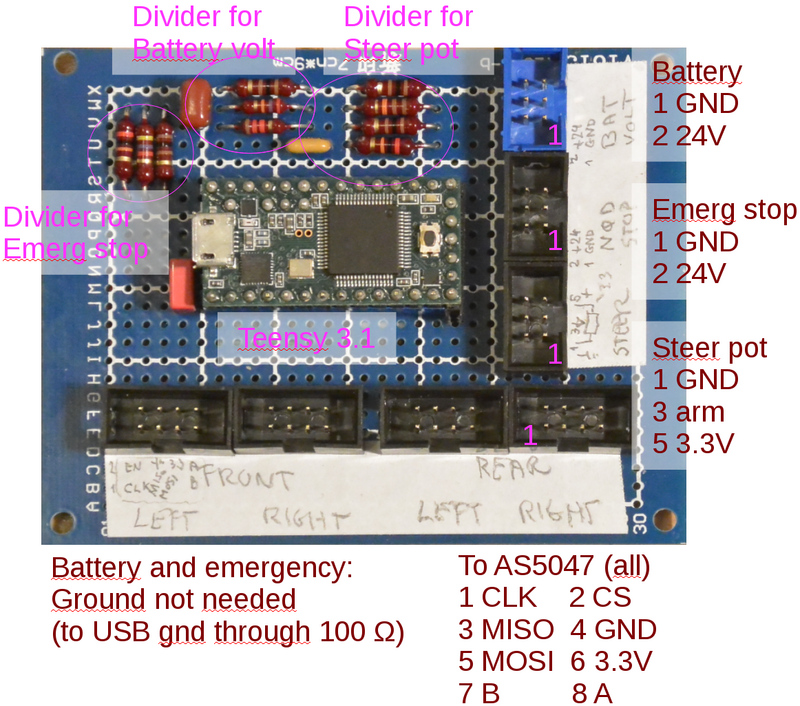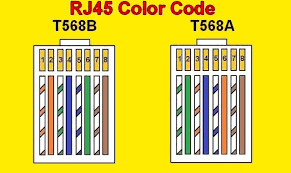Wheel encoder: Difference between revisions
| Line 97: | Line 97: | ||
There will be dropped messages, when no one reads from /dev/ttyACM0 | There will be dropped messages, when no one reads from /dev/ttyACM0 | ||
Other messages | Other messages has this format: | ||
enc : keyword | enc : keyword | ||
| Line 107: | Line 107: | ||
5350: encoder rear right | 5350: encoder rear right | ||
60 : magnet distance rear right (fine) | 60 : magnet distance rear right (fine) | ||
2700: encoder value steering | 2700: encoder value steering (not stable in this printout) | ||
1 : valid value (steering) | 1 : valid value (steering) | ||
Revision as of 16:02, 19 June 2019
Back to TerrainHopper
Introduction
Wheel encoders are intended on all 4 motors, replacing the brake.
Initially rear motors are mounted with encoders. The encoders are of type AS5057 12 bit magnetic encoders.
Additionally encoder A and B signals are forwarded, but not enabled.
Board
Encoder interface is I2C and interfaced using a Teensy 3.1 processor, as shown in figure 1.
Figure 1. Breadboard with Teensy 3.1 and 4 8-pin connectors to the AS5047 boards. The board also holds the needed voltage dividers for battery voltage and steering potentiometer.
FRONT-RIGHT is changed to be steering encoder (may 2019).
Encoder interface
Signal wires to encoders has a 100 Ohm serial resistor (CLK, MISO, MOSI (and CS on rear encoders))
- pin 1: CLK (green-white)
- pin 2: Chip select (green)
- pin 3: MISO (orange-white)
- pin 4: GND (blue)
- pin 5: MOSI (blue-white)
- pin 6: 3.3V (orange)
- pin 7: B quadrature signal (brown-white)
- pin 8: A quadrature signal (brown)
Wires using unshielded network cable (cat-5)
NB! some network cables have different color coding in the rj45 side of the connector. The coding above conforms to T568A, but the cables used on the terrainhopper uses T568B,
but as long as both cables are the same, then it should be OK.
Connection to Teensy
CLK on all ports -> 100 Ohm -> pin 14 (CLK) on Teensy MISO on all ports -> 100 Ohm -> pin 8 (DIN) MOSI on all ports -> 100 Ohm -> pin 7 (DOUT) 3.3V on all ports to pin 3.3V on Teensy
Chip select:
Rear Right -> 100 Ohm -> pin 9 Rear Left -> 100 Ohm -> pin 15 Steer -> 0 Ohm -> pin 20 Front Left -> 0 Ohm -> pin 21
Encoder A, B
Rear Right -> 0 Ohm -> pin 18 (A), 17 (B) Rear Left -> 0 Ohm -> pin 4 (A), 5 (B) Steer -> 0 Ohm -> pin 2 (A), 3 (B) Front Left -> 0 Ohm -> pin 0 (A), 1 (B)
Voltage dividers
The Teensy AD converter for battery voltage and steering potentiometer uses 1.2V reference. The signals therefore needs voltage dividers.
Battery
The battery voltage divider uses a 27kOhm and a 1.2kOhm, allowing up to 28.2V to be measured. (in (optional) ground connection is mounted a 100 Ohm resistor to avoid or limit any ground current). There is a filter capacitor of 390nF.
Connected to pin (23) A9 on Teensy
Steering potentiometer
The steering potentiometer is supplied from 3.3V supply (through 100 Ohm resistors). The arm is then voltage divided using a 20kOhm and 11kOhm resistors, with a filter capacitor of 330nF.
Potentiometer arm is connected to pin (19) A5 on Teensy.
Debug output
The Teensy constantly blinks with LED every second.
The output should look something like:
$ cat /dev/ttyACM0 enc 0.0 0 1 7905 55 5349 60 2204 1 # dropped 48 msgs enc 0.0 0 1 7906 55 5350 60 2700 1 enc 0.0 0 1 7906 55 5353 60 668 1 enc 0.0 0 1 7907 55 5351 60 3142 0 enc 0.0 0 1 7906 55 5354 60 2700 1 enc 0.0 0 1 7907 55 5351 60 2780 1 enc 0.0 0 1 7906 55 5352 60 668 1 enc 0.0 0 1 7905 55 5351 60 3740 1 enc 0.0 0 1 7906 55 5353 60 668 0 enc 0.0 0 1 7907 55 5352 60 2204 1
There will be dropped messages, when no one reads from /dev/ttyACM0
Other messages has this format:
enc : keyword 0.0 : intended for battery voltage (V) (not realy tested) 0 : emergency switch (1=24V) (not realy tested) 1 : value from steering potentiometer (value 1 is a bit odd) 7906: encoder rear left 55 : magnet distance rear left (fine) 5350: encoder rear right 60 : magnet distance rear right (fine) 2700: encoder value steering (not stable in this printout) 1 : valid value (steering)
Emergency stop
This is intended to inform software that emergency stop is pressed - pt. only one channel for rear emergency stop, but maybe the remote should be separate.
A voltage divider is added on the emergency line with 20kOhm and 4.7kOhm, this should give a switch voltage of about 7V - assuming supply from 24 V.
Connected to pin 22 (A8) on Teensy.

